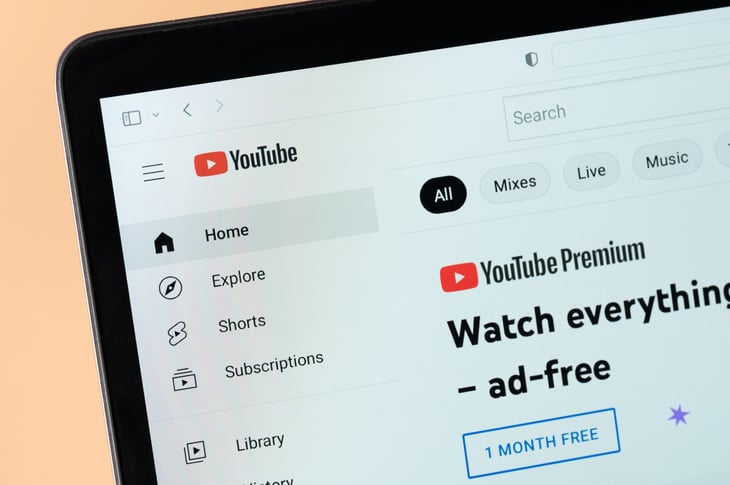
Are you wasting hundreds of dollars each month on subscriptions? You might be surprised to find that you are.
According to C + R Research, consumers spend about $219 monthly on subscription services. If you’re trying to find a little extra cash each month, you might benefit from getting rid of some of your subscription services.
1. Gym membership

Are you truly going to the gym as much as you expect? If not, you might consider canceling your gym membership. If you want to exercise, you can take a walk, ride a bike or purchase some hand weights. YouTube is full of workouts you can do at home, including strength-building exercises using only your body weight.
2. YouTube Premium

If you’re paying $13.99 per month for YouTube Premium, double-check whether you’re getting true value from this service. It comes with background play and provides ad-free viewing. However, do you watch YouTube enough to use these features? Do you need YouTube playing in the background while you use other apps? By canceling YouTube Premium you could save $168 per year.
3. Cable TV

Haven’t cut the cord yet? Rather than paying monthly for cable or satellite TV, consider a service like Pluto TV. You can drop into this streaming service to watch hundreds of channels just like watching live cable TV. There are also thousands of on-demand movies available.
Plus, Pluto TV is free. You might have to watch ads, but at least you aren’t paying for cable — where you have to watch ads despite paying for the service. And Pluto TV is just one of more than a dozen free movie and TV streaming services.
4. Video streaming services

These days, it seems like everyone has a streaming service. Unfortunately, canceling your streaming service is the only way to stop getting charged each month. Review your bank statements and check to see how many streaming services you have. Then, consider how often you use them. You can cancel Netflix, Hulu or Disney+ by going to your account page and canceling your subscription or membership.
Another option is to see if your cellphone provider has a deal. For example, Verizon offers six months of Disney+ with certain plans (make sure you cancel at the end of six months if you’re not using it), and T-Mobile has similar offers of Apple TV+ and Netflix.
5. Music streaming services

Again, if you’re not regularly using music streaming services, paying for them each month can start to add up —especially if you’re signed up for several services. Review your usage and determine whether you need to stop paying that monthly fee.
In the case of some services, you might have subscribed through a third party. For example, Amazon Music Unlimited has different requirements, depending on how you signed up for your account. If you signed up through iTunes, you must cancel through Apple. If you signed up on Amazon, you can manage your music subscription from your Amazon account.
With Spotify, you can choose to cancel your premium (paid) account. You must go to your account plan and then choose “Change Plan.” From there, you can cancel your premium plan and still have access to free music streaming through Spotify. You can save money if you only listen occasionally and can deal with the ads.
6. Subscription boxes

Getting a box full of geeky toys or having pet items sent to you regularly is probably fun. However, these boxes cost money monthly, and they might fill your home with clutter. Review the boxes that keep coming your way and evaluate whether you actually use the items. If you find you’re not using what you get, cancel the box and enjoy a cleaner home while saving money.
7. Amazon Subscribe & Save

Amazon touts the ability to save up to 15% on items when you use Subscribe & Save to have products delivered regularly to your home. However, even a 15% discount might not be true savings in the long run if these purchases start piling up and you aren’t using them fast enough.
Even if you don’t completely cancel all of your subscriptions, consider reviewing the frequency you receive them. Perhaps you’re better off receiving certain items every six months rather than every three months. Review your usage and make adjustments so you aren’t spending unnecessary money.
8. Premium mobile apps

Perhaps you signed up for a free trial of a premium mobile app, and now you’re paying a monthly fee or being charged annually. Several premium apps help you do everything from meditating to organizing your finances. But what if you could get a similar service for free?
Calm costs $69.99 per year after a free trial, but Insight Timer offers ongoing free access to similar guided meditations. You can get a free version of the financial app PocketGuard, rather than paying $34.99 or more for a premium budgeting app.
9. Credit monitoring services

Are you paying for credit monitoring that you could be getting for free? A service like Identity Force from credit reporting company TransUnion could charge you up to $240 per year. Or you might pay $24.99 monthly for one of Experian‘s monitoring services. But what if you didn’t need to pay to monitor your credit?
Annual Credit Report offers weekly access to your credit reports. This is the official website that provides free credit reports as required by law. You can also use free services like Credit Karma to keep tabs on what’s happening with your credit. Some banks even offer ongoing services for free, such as Capital One’s CreditWise product. You might not need to pay for a subscription when you can get similar information for free.
10. Delivery services

Some grocery delivery services offer advanced accounts that cost extra money. You get free delivery on orders that exceed a certain amount, and you might get other discounts and perks. Both DoorDash and Instacart have versions that come with a monthly cost of $9.99.
But do you actually receive delivery enough to make the cost worth it? And are the savings on delivery adding up? Review your costs to determine whether you might be just fine without paying the ongoing subscription cost.
11. Online news sites and magazines

Are you reading The New York Times or The Wall Street Journal enough to pay for monthly access to stories? Other publications also charge monthly costs to access them online; you might be surprised at how it’s all adding up. Perhaps it makes sense to pick one and keep it. Or check the library to see if they offer free access through their system. Another option is to get a digital subscription to your local newspaper and support their work.





Add a Comment
Our Policy: We welcome relevant and respectful comments in order to foster healthy and informative discussions. All other comments may be removed. Comments with links are automatically held for moderation.